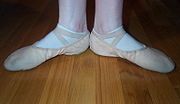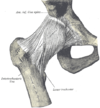
Turnout (ballet)
Encyclopedia

Ballet
Ballet is a type of performance dance, that originated in the Italian Renaissance courts of the 15th century, and which was further developed in France and Russia as a concert dance form. The early portions preceded the invention of the proscenium stage and were presented in large chambers with...
, turnout (also turn-out) is a rotation of the leg which comes from the hips, causing the knee
Knee
The knee joint joins the thigh with the leg and consists of two articulations: one between the fibula and tibia, and one between the femur and patella. It is the largest joint in the human body and is very complicated. The knee is a mobile trocho-ginglymus , which permits flexion and extension as...
and foot
Foot
The foot is an anatomical structure found in many vertebrates. It is the terminal portion of a limb which bears weight and allows locomotion. In many animals with feet, the foot is a separate organ at the terminal part of the leg made up of one or more segments or bones, generally including claws...
to turn outward, away from the center of the body. This rotation allows for greater extension of the leg, especially when raising it to the side and rear. Turnout is essential to classical ballet
Classical ballet
Classical Ballet is the most formal of the ballet styles, it adheres to traditional ballet technique. There are variations relating to area of origin, such as Russian ballet, French ballet, British ballet and Italian ballet...
technique
Ballet technique
The core technique of ballet has only minor regional variations globally. Various training methods have been devised, these produce a different physicality of performance and aesthetic results...
and is the basis on which all ballet movement follows.
Range and nature of turnout
Turnout is measured in degreesDegree (angle)
A degree , usually denoted by ° , is a measurement of plane angle, representing 1⁄360 of a full rotation; one degree is equivalent to π/180 radians...
with the perfect turnout measured at 180°. The angle measured is that between the feet when the heel
Heel
In human anatomy, the heel is the prominence at the posterior end of the foot. It is based on the projection of one bone, the calcaneus or heel bone, behind the articulation of the bones of the lower leg.- Human anatomy :...
s are touching in first position
Positions of the feet in ballet
The positions of the feet in ballet is a fundamental part of classical ballet technique that defines proper placement of feet on the floor. There are five basic positions of the feet in modern-day classical ballet, known as the first through fifth positions...
. Perfect turnout is rarely attainable at the first attempt.

Some dancers will anterior pelvic tilt (shortening the hip flexors) because hip flexion reduces the tension on the ligament and allows lateral hip rotation to occur more easily. This will however, affect the dancer's posture, since it requires the back to hyper-extend to remain upright.
The extent to which an individual can rotate their legs is largely predetermined. The degree of turnout attainable is determined by the shape of the femoral neck
Femur
The femur , or thigh bone, is the most proximal bone of the leg in tetrapod vertebrates capable of walking or jumping, such as most land mammals, birds, many reptiles such as lizards, and amphibians such as frogs. In vertebrates with four legs such as dogs and horses, the femur is found only in...
and the angle at which the femoral head is inserted into the hip socket
Hip (anatomy)
In vertebrate anatomy, hip refer to either an anatomical region or a joint.The hip region is located lateral to the gluteal region , inferior to the iliac crest, and overlying the greater trochanter of the femur, or "thigh bone"...
, the orientation of the hip socket, the elasticity of the iliofemoral ligament
Iliofemoral ligament
The iliofemoral ligament is a ligament of the hip joint which extends from the ilium to the femur in front of the joint. It is also referred to as the Y-ligament or the ligament of Bigelow, and any combinations of these names....
, and the flexibility of the hip and thigh muscles. However, the structure of the bone may be influenced by ballet exercises before a certain period of bone development attained around the age of eleven.
The action of turning out the leg is more important to ballet movement than the angle that is attained. Even while standing, turnout must be maintained through an active rotation with the muscles that extends from the hip to the foot.

